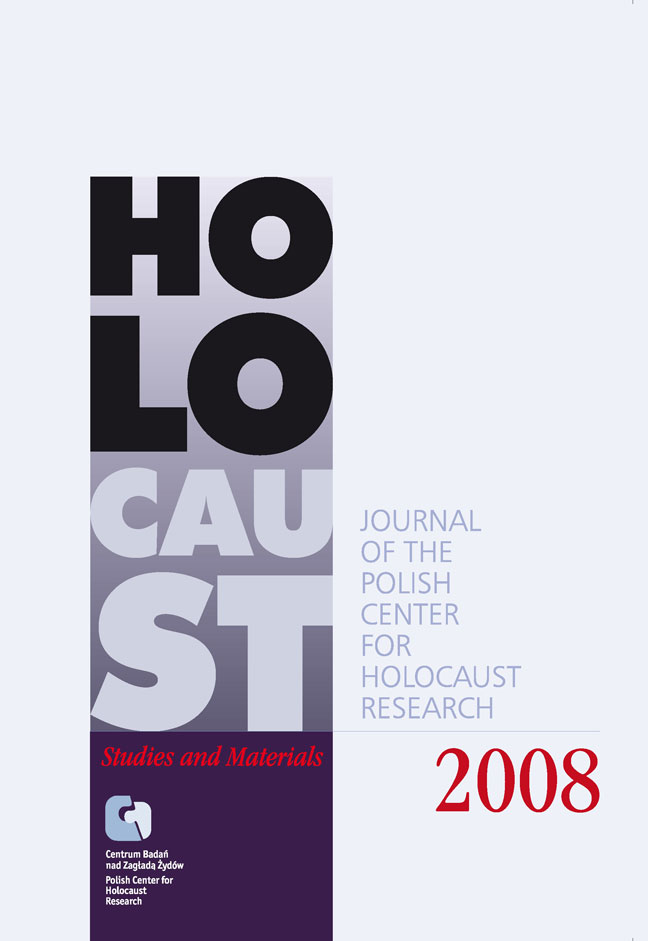Błoński’s Essay Years Later
Zagłada Żydów. Studia i Materiały, 2008, Strony: 23-30
Data zgłoszenia: 2020-09-25Data publikacji: 2008-12-01
 https://doi.org/10.32927/ZZSiM.55
https://doi.org/10.32927/ZZSiM.55
Abstrakt
The author reflects upon Jan Błoński’s essay “Biedni Polacy patrzą na getto” (Poor Poles look at the ghetto) nearly twenty years of its publication by Tygodnik Powszechny. He points at the innovative character of the depiction of Polish-Jewish issues in the moral context, outside of all the political embroilments. Błoński’s voice is unique, because it acknowledges, in the spirit of the Gospels, that analysis of Polish- -Jewish relations is a fundamental issue for the Polish society, a “homework” that needs to be done. This essay, Głowiński claims, is free from the embroilment in the dualism of the negative and positive myths regarding these relations. The author writes about reactions to this text, the letters to the editor and notes one particular voice, which he reads as an internalised nationalist ideology and the dangerous continuation of the nationalist discourse. Głowiński’s sketch concludes the post scriptum, in which the author refers to another article, published in 2006 by Gazeta Wyborcza, regarding the current historical policy, whose proponents see Błoński’s essay as a negative reference
point. The author notes that this essay constantly evokes strong emotions, and, as an expression of critical patriotism, still has its ardent opponents.
Licencja
Prawa autorskie (c) 2008 Autor&"Zagłada Żydów. Studia i Materiały"

Utwór dostępny jest na licencji Creative Commons Uznanie autorstwa 4.0 Międzynarodowe.
https://creativecommons.org/licenses/by/4.0
Czasopismo publikowane jest w standardzie Diamond Open Access na licencji CC-BY-4.0 Deed - Uznanie autorstwa 4.0 Międzynarodowa - Creative Commons
Inne teksty tego samego autora
- Michał Głowiński, Jan Błoński "Biedni Polacy patrzą na getto” w 20 lat później , Zagłada Żydów. Studia i Materiały: Nr 2 (2006)
- Michał Głowiński, Mordechaj Chaim Rumkowski – postać rzeczywista i bohater legend , Zagłada Żydów. Studia i Materiały: Nr 9 (2013)
- Michał Głowiński, Oczy donosiciela , Zagłada Żydów. Studia i Materiały: Nr 10 (2014)
- Michał Głowiński, Życiorys Batji Klig , Zagłada Żydów. Studia i Materiały: Nr 7 (2011)
Podobne artykuły
- Agnieszka Haska, Fakty i fikcje. Na marginesie filmu Azyl , Zagłada Żydów. Studia i Materiały: Nr 13 (2017)
- Agnieszka Haska, Adam Żurawin – bohater o tysiącu twarzy , Zagłada Żydów. Studia i Materiały: Nr 2 (2006)
- Maciej Kubicki, O niemieckim filmie propagandowym z warszawskiego getta. Przyczynek do analizy , Zagłada Żydów. Studia i Materiały: Nr 2 (2006)
- Dariusz Libionka, Barbara Engelking, Anki Grupińskiej zapisywanie żydowskich opowieści (12 opowieści żydowskich); Odczytanie listy. Opowieści o warszawskich powstańcach Żydowskiej Organizacji Bojowej , Zagłada Żydów. Studia i Materiały: Nr 10 (2014)
- Agnieszka Haska, Adam Żurawin, a Hero of a Thousand Faces , Zagłada Żydów. Studia i Materiały: 2008: Holocaust Studies and Materials
- Jan Tomasz Gross, Sprawcy, ofiary i inni , Zagłada Żydów. Studia i Materiały: Nr 10 (2014)
- Romuald Jakub Weksler-Waszkinel, Father Stanisław Musiał's Struggle with Memory , Zagłada Żydów. Studia i Materiały: 2008: Holocaust Studies and Materials
- Jean-Charles Szurek, Proces Gustava Wilhelma Trappa 6 lipca 1948 r , Zagłada Żydów. Studia i Materiały: Nr 9 (2013)
- Bartomiej Grzanka, Działalność SS-Sonderkommando Kulmhof w lutym i marcu 1942 r. w świetle dowodów księgowych Sonderkonto 12300 z zasobu Archiwum Państwowego w Łodzi , Zagłada Żydów. Studia i Materiały: Nr 16 (2020)
- Barbara Engelking, Sny jako źródło do badań nad Zagładą , Zagłada Żydów. Studia i Materiały: Nr 9 (2013)
<< < 28 29 30 31 32 33 34 35 36 37 38 39 40 41 42 43 44 45 46 47 48 49 50 51 52 53 54 55 56 57 58 59 60 61 62 63 64 65 66 67 68 69 70 71 72 73 74 75 76 77 > >>
Możesz również Rozpocznij zaawansowane wyszukiwanie podobieństw dla tego artykułu.
 English
English
 Język Polski
Język Polski




